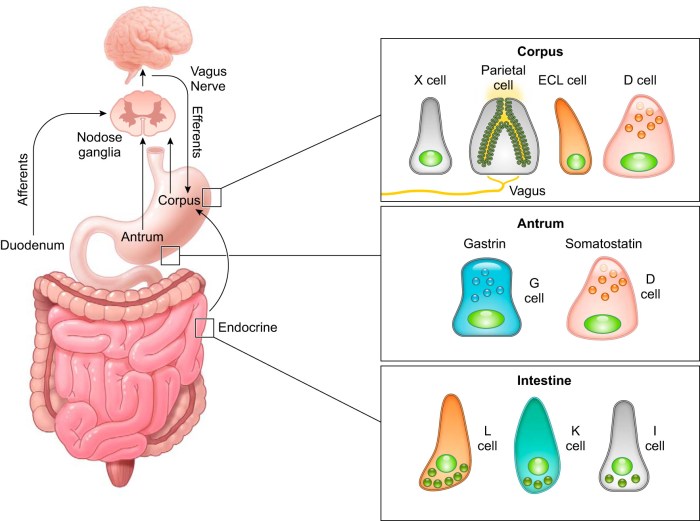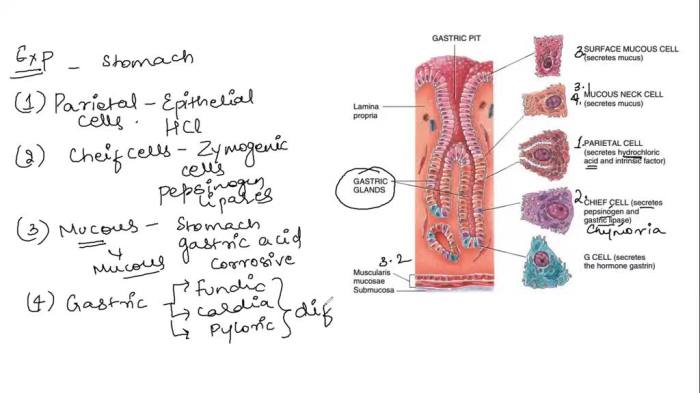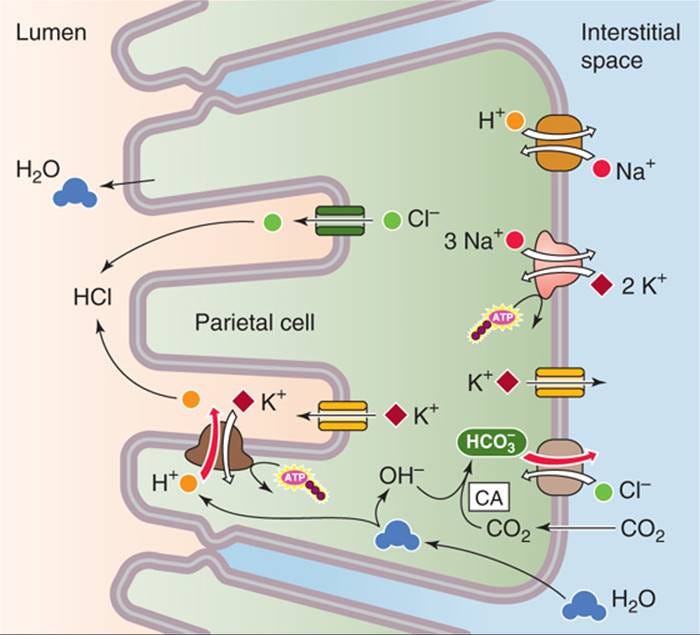Match the secretory cell of the stomach with its secretion. – Delving into the intricate relationship between gastric secretory cells and their secretions, this comprehensive guide unravels the fundamental principles governing the digestive process within the stomach. This exploration unveils the diverse secretory cells lining the gastric mucosa, their distinct morphological characteristics, and their pivotal role in producing a symphony of secretions that orchestrate digestion.
Each secretory cell, meticulously positioned within the gastric mucosa, exhibits unique morphological features that mirror its specialized function. From the parietal cells, responsible for hydrochloric acid production, to the chief cells, secreting pepsinogen, and the mucous neck cells, contributing to the protective mucus layer, this guide meticulously examines the intricate interplay between these cells and their secretions.
1. Secretory Cells of the Stomach

The stomach, a vital organ in the digestive system, is lined with a complex array of secretory cells that play crucial roles in digestion. These cells, located within the gastric mucosa, produce a diverse range of secretions essential for the proper breakdown and absorption of nutrients.
1.1 Location and Distribution
Secretory cells are distributed throughout the gastric mucosa, with distinct populations residing in specific regions:
- Fundic glands:Located in the fundus and body of the stomach, fundic glands secrete gastric juice, a highly acidic fluid containing pepsin and hydrochloric acid.
- Pyloric glands:Found in the pyloric region, pyloric glands produce mucus and bicarbonate ions to neutralize stomach acid.
1.2 Morphological Characteristics
Each type of secretory cell exhibits unique morphological characteristics:
- Parietal cells:Large, polygonal cells that secrete hydrochloric acid.
- Chief cells (peptic cells):Pyramidal cells that secrete pepsinogen, the precursor to pepsin.
- Mucous neck cells:Mucus-secreting cells located at the junction of fundic and pyloric glands.
- G cells (enterochromaffin-like cells):Neuroendocrine cells that secrete gastrin, a hormone that stimulates gastric secretion.
2. Gastric Secretions
The stomach secretes a variety of fluids that aid in digestion. These secretions include:
2.1 Gastric Juice
Gastric juice is a highly acidic fluid produced by parietal cells. It contains:
- Hydrochloric acid (HCl):Acidifies the stomach contents, creating an optimal environment for pepsin activity and killing microorganisms.
- Pepsin:A protease enzyme that breaks down proteins into smaller peptides.
pH: 1.5-2.5
2.2 Mucus
Mucus is a viscous fluid produced by mucous neck cells and pyloric glands. It protects the gastric mucosa from the acidic environment and provides lubrication for food movement.
pH: 7.0-8.0
2.3 Bicarbonate Ions
Bicarbonate ions are produced by pyloric glands. They neutralize stomach acid as food enters the duodenum, preventing damage to the small intestine.
pH: 8.0-9.0
3. Matching Secretory Cells to Secretions

| Secretory Cell | Secretion | Function of Secretion |
|---|---|---|
| Parietal cells | Hydrochloric acid | Acidifies stomach contents, activates pepsin |
| Chief cells | Pepsinogen | Precursor to pepsin, breaks down proteins |
| Mucous neck cells | Mucus | Protects gastric mucosa, lubricates food |
| G cells | Gastrin | Stimulates gastric secretion |
4. Regulation of Gastric Secretion
Gastric secretion is tightly regulated by a complex interplay of hormones, neural pathways, and local factors:
4.1 Hormonal Control
- Gastrin:Stimulates parietal and chief cells to secrete gastric juice.
- Secretin:Inhibits gastric secretion in response to acidic duodenal contents.
- Cholecystokinin (CCK):Inhibits gastric secretion in response to fatty foods.
4.2 Neural Control
- Vagus nerve:Stimulates gastric secretion through the release of acetylcholine.
4.3 Local Factors
- pH:Acidic pH inhibits gastric secretion, while alkaline pH stimulates secretion.
- Peptides and amino acids:Stimulate gastrin release and gastric secretion.
5. Clinical Implications: Match The Secretory Cell Of The Stomach With Its Secretion.

Impaired gastric secretion can lead to various gastrointestinal disorders:
5.1 Achlorhydria
Absence of hydrochloric acid secretion, leading to impaired protein digestion and an increased risk of bacterial infections.
5.2 Hypochlorhydria
Reduced hydrochloric acid secretion, resulting in insufficient acidification of the stomach contents and impaired pepsin activity.
5.3 Peptic Ulcer Disease, Match the secretory cell of the stomach with its secretion.
Ulcers in the stomach or duodenum, often caused by excessive acid secretion or impaired mucosal protection.
5.4 Diagnostic Tests
- Gastric analysis:Measures the pH and volume of gastric secretions.
- Gastroscopy:Visual examination of the stomach lining to assess for abnormalities.
- Biopsy:Removal of a small tissue sample for microscopic examination.
Helpful Answers
What is the primary function of parietal cells?
Parietal cells are responsible for producing hydrochloric acid (HCl), which plays a crucial role in activating pepsinogen and creating an acidic environment essential for protein digestion.
How do chief cells contribute to digestion?
Chief cells secrete pepsinogen, which is converted into the active enzyme pepsin in the acidic environment of the stomach. Pepsin initiates protein digestion by breaking down protein molecules into smaller peptides.
What is the role of mucous neck cells in gastric secretion?
Mucous neck cells secrete mucin, a glycoprotein that forms a protective mucus layer lining the gastric mucosa. This layer shields the stomach lining from the acidic environment and prevents damage.